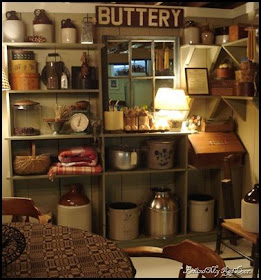With so many food storage options at our fingertips in today's world, I wondered how people in the 19th and well into the 20th century kept food cool and from spoiling.
Because a root cellar plays an important role in my upcoming release, Winning the Widow's Heart, I did some research and discovered that pantries are universal whether they are called a butler's pantry, a keeping room, a larder, or a dairy.
The word "pantry" comes from the Old French word "paneterie" meaning from "pain", the French word for bread. In medieval times food and supplies were stored in specific rooms. Meats were stored in a larder, alcohol stored in the buttery, and bread was stored in the pantry.
Before 1850, settlers in early American homes, where space was tight and possessions few, stored dry goods and spices in a cabinet or trunk. However, small rooms adjacent to the kitchen hearth began to appear in colonial houses for all manner of food storage. Early pantries--especially in the self-sufficient farmhouse--were unheated and primitive, with simple wood shelving on which to store barrels of dry goods and other bulk staples, as well as cooking utensils. Dark, cool, and dry, the pantry necessarily had a door or cloth covering over the entry to keep out dirt.
Milk room or dairies, many spring-fed, were often adjacent to farmhouse kitchens. Well-insulated dugouts (a walk-in, cave-like structure built into a hill) also ensured safe storage for perishables or preserves.
By the end of the Civil War and the 1920s, pantries were commonplace in homes of all styles, often with a servant's room above or adjacent to the kitchen.
Types of Pantries
Butler's Pantry A Victorian invention, it is a separate space adjacent to the dining room where food could be prepped and readily served, and where dishes often were washed in a "soft", copper-lined sink. It generally included storage space for tableware, serving pieces, and the family "plate" or silverware, which was the butler's responsibility.
Buttery (or butt'ry) An old-fashioned word for the pantry or larder found in old farmhouses. This doesn't refer to butter but come from an English term for secondary pantry storage where more extensive provisions were stored in large barrels called "butts".
Keeping Pantry An old English and New England term for a family sitting room immediately adjacent to the kitchen.
Larder A small, cold room for storage of perishable food and prepared foods in the hottest weather.
It had slate or marble shelves two or three inches thick. Originally, it was where raw meat was larded--covered in fat--to be preserved. A dry larder was where bread, pastry, milk, butter, or cooked meats were stored.
Milk Room Also called the dairy, this was a cool work room, often with running water from a spring, within the farmhouse and adjacent to the kitchen where butter
Hoosier Cabinets Made by the Hoosier Manufacturing Company in Indiana,
this cabinet was created to be an all-in-one pantry and kitchen for the new
American home. These cabinets stood about six feet high, four feet wide and about two feet deep--making it a perfect size for small kitchens. It had built in storage bins and containers for everyday items like flour, sugar, coffee, tea and household spices.
Summer Kitchen
Located in the ell or wing of old farmhouses or, in hot climates, in a separate structure, it's a room apart where food was prepared in summertime. It was cooler and better ventilated than the main kitchen, and its usage kept cooking heat away from living quarters.
Even today, regardless of your kitchen size, you most likely have a pantry. It might be as small as a shelf in a cupboard or as large as a walk-in closet. Or if you're like me, you can remember your parents having a pantry just off the kitchen.
We have one now which we call the "Mary Poppins" closet. When we moved into the house, anything we didn't have a place for went in the closet until we were further along in our unpacking. So now, when my husband can't find something, I tell him to look in the "Mary Poppins closet".
P.S. Only those who know the story of Mary Poppins and her carpetbag will understand!!!
April 26th Release!










No comments:
Post a Comment
Thank you for visiting Sweethearts of the West! We are very sad to require comment moderation now due to the actions of a few spam comments. Thank you for your patience.